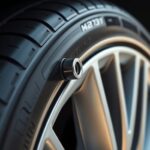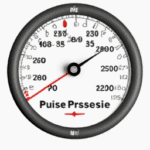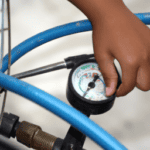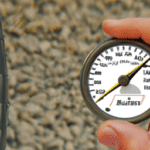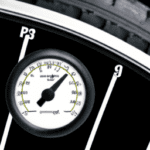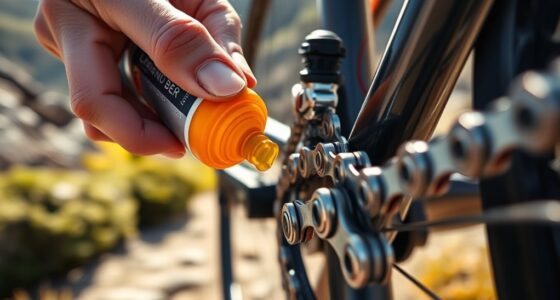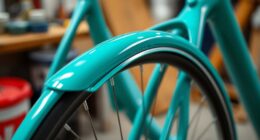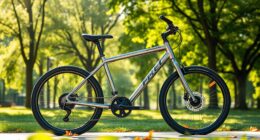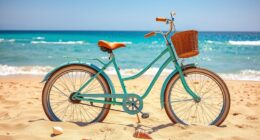Maintaining proper bike tire pressure is key to safer, smoother rides and better performance. When you inflate tires to the right level, you reduce rolling resistance, improve traction, and absorb shocks better. The ideal pressure depends on your bike type, terrain, rider weight, and weather conditions. Checking and adjusting your tire pressure regularly helps prevent flats and wear. Keep exploring to discover how specific factors influence the best pressure for your cycling adventures.
Key Takeaways
- Proper tire pressure reduces rolling resistance, improving speed and efficiency during rides.
- Correct inflation enhances traction, handling, and comfort on different terrains.
- Regularly checking and maintaining tire pressure prevents uneven wear and flats.
- Tire sidewalls display recommended PSI or BAR ranges for safe and optimal inflation.
- Terrain, bike type, and weather influence ideal tire pressure settings for safety and performance.
The Role of Proper Tire Inflation in Cycling Performance
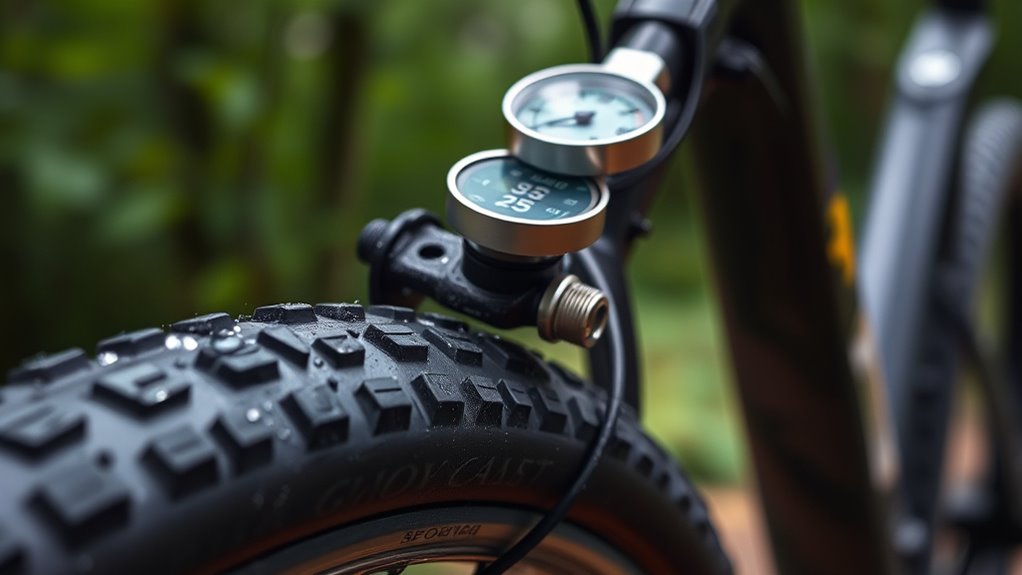
Proper tire inflation plays a crucial role in enhancing your cycling performance. When your tire pressure is just right, it reduces rolling resistance, which can boost your speed by up to 5%. Proper inflation also helps your tires absorb shocks better, giving you a smoother ride and less fatigue. With ideal tire pressure, you’ll enjoy improved traction and handling, especially on uneven terrains, making your ride safer and more efficient. Regularly checking and maintaining the correct tire pressure ensures you get maximum efficiency, safety, and comfort every time you cycle. Maintaining proper tire pressure is essential for peak cycling performance, and maintaining correct tire pressure supports overall tire health and longevity. Additionally, monitoring your tire pressure regularly can prevent unexpected blowouts caused by improper inflation. Understanding how family dynamics influence your cycling habits can also help you develop better maintenance routines. Consistent maintenance of your tires ensures optimal performance and extends their lifespan.
How to Read and Interpret Tire Pressure Measurements
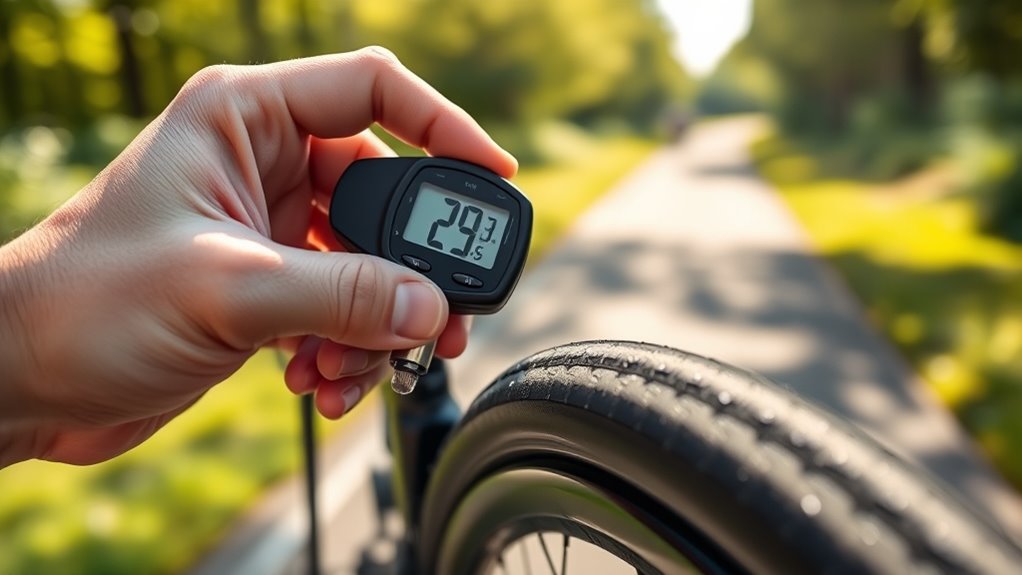
To properly read your bike tire pressure, first check the gauge in PSI or BAR, depending on your region or preference. Look closely at the sidewall of the tire, where the recommended pressure range is printed, and use a quality, bike-specific gauge for accuracy. Understanding these measurements helps you maintain safe, efficient riding conditions and tire longevity. Additionally, maintaining proper tire pressure is essential for optimal performance and safety during your rides Honda Tuning. Proper tire pressure also contributes to the efficiency of your bike, ensuring a smoother and safer ride. Being aware of industry transformations like AI automation can inspire innovative maintenance techniques for your bike. Regularly checking and adjusting your tire pressure can prevent uneven wear and reduce the risk of flats, which is especially important as technology advances in tire pressure monitoring systems. Staying informed about technological innovations can further enhance your ability to keep your bike in top condition.
PSI vs. BAR
Understanding tire pressure measurements means knowing the difference between PSI and BAR, the two most common units used worldwide. PSI, or Pounds per Square Inch, is popular in the United States, while BAR is widely used in Europe and other regions. To convert between them, remember that 1 PSI is about 0.069 BAR, and 1 BAR equals roughly 14.5 PSI. Most bike pumps display both units, so you can easily read your tire pressure in your preferred measurement. When checking your tires, make certain they are cold, as heat can temporarily raise pressure readings. Properly interpreting PSI and BAR helps you maintain the correct pressure, which is essential for performance, safety, and protecting your rim width. Accurate measurement ensures a smoother, safer ride, especially when considering different types of headphones that may be used during cycling activities. Additionally, understanding AI-powered sensor technology in modern pumps can further improve accuracy and ease of maintenance. Being aware of digital pressure gauges can also aid in achieving precise readings and monitoring your tire pressure over time, which contributes to overall well-being during cycling.
Reading Tire Sidewall
Ever wonder how to tell if your bike tire is inflated correctly just by looking at the sidewall? The key is reading the sidewall markings. These markings usually display the recommended PSI range, such as “90-115 PSI,” guiding you to inflate within safe limits for ideal performance. To interpret the measurement, find the number followed by “PSI” or “BAR.” If no specific pressure is listed, inflate until the tire feels firm but still slightly squeezable, aligning with typical bike standards. Keep these in mind:
- Check the recommended PSI range printed on the sidewall
- Understand the minimum and maximum values
- Use sidewall markings as a guide for safe inflation
- Ensure your tire is within the recommended PSI for safety and longevity
- Regularly check your tire pressure to maintain optimal performance and avoid unnecessary wear. Proper tire pressure maintenance is essential for a smooth and safe ride. Being aware of pressure guidelines helps maintain proper tire pressure during every ride.
Additionally, understanding the cultural significance of proper bike maintenance can foster a greater appreciation for the craftsmanship behind your equipment.
Using Proper Equipment
Using proper equipment is essential for accurately measuring your bike tire pressure. A high-quality, dedicated bike pump with an integrated gauge or a reliable separate pressure gauge guarantees accurate measurement. Regularly check your tires when they’re cold, as riding heats up the tires and can give false readings. Digital gauges often provide more precise readings within ±1 PSI, making them a good choice. Remember to calibrate your gauge periodically for consistent accuracy. Use the tire’s sidewall markings as a guide, comparing your readings to the recommended pressure range. Proper equipment helps you interpret measurements correctly, preventing under- or over-inflation that could compromise safety or performance. Incorporating accurate measurement techniques and understanding tire pressure guidelines ensures your tires are maintained at optimal pressure for safety and efficiency.
Factors That Influence Optimal Tire Pressure

Your rider weight plays a key role in determining the right tire pressure; heavier riders usually need 3-5 PSI more for proper support. The terrain and surface type also matter, as smooth roads call for higher PSI, while rough or off-road surfaces benefit from lower pressures. Additionally, tire and rim compatibility influence ideal pressure, with wider rims supporting lower PSI for better comfort and traction.
Rider Weight Impact
How much you weigh directly influences the ideal tire pressure for your bike. Heavier riders need higher tire pressures—typically 3-5 PSI more for every 20-30 pounds—to prevent tire deformation and guarantee optimal support. For example, a 200-pound rider might require about 10-15 PSI more than someone weighing 150 pounds. If you under-inflate, especially as a heavier rider, you risk pinch flats, increased rolling resistance, and uneven tire wear. Conversely, lighter riders can often run lower pressures, boosting comfort and traction without compromising safety. Adjusting your tire pressure based on rider weight helps improve handling, safety, and overall performance. Remember, the right pressure isn’t one-size-fits-all; it’s tailored to your weight for the best cycling experience.
Terrain and Surface Type
The type of terrain and surface you ride on play a critical role in determining the ideal tire pressure for your bike. For smooth surfaces like paved roads, higher pressure (80-130 PSI) reduces rolling resistance, helping you ride faster. On rougher terrains such as gravel, dirt, or snow, lower pressure (20-50 PSI) improves traction and shock absorption by increasing the contact area with the ground. Excessively high pressure on uneven surfaces can cause a jarring ride and risk rim damage or pinch flats, especially on rocky trails. Mountain biking typically involves lower pressures (30-50 PSI) to enhance grip and comfort over obstacles, while racing on smooth roads demands higher pressures for speed. Adjusting pressure based on terrain ensures better traction, comfort, and durability.
Tire and Rim Compatibility
Matching your tire width to the rim is essential for ideal pressure and safe riding. Proper tire and rim compatibility ensures your tire seats correctly and maintains the right pressure. When choosing tires, pay attention to rim width, as wider rims support lower tire pressures without risking rim damage, boosting traction and comfort. Using tires that are too narrow for the rim can increase rolling resistance and reduce stability, requiring higher pressures for safety. Rim width directly influences the tire pressure range printed on the sidewall, guiding you to perfect inflation levels. To maximize performance and safety, consider these factors:
- Correct matching of tire and rim dimensions
- Rim width’s impact on tire pressure range
- Benefits of wider rims for lower pressures
- Avoiding mismatched sizes to prevent blowouts
Selecting the Right Inflation for Different Bike Types
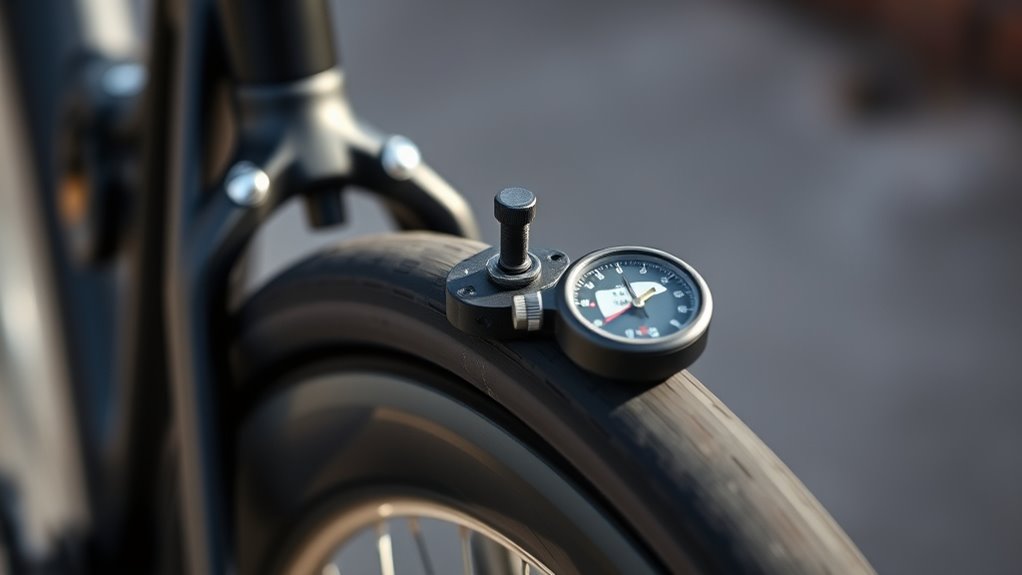
Choosing the right tire pressure depends on your bike type and riding conditions. Each bike type has a recommended range of tire pressure to optimize performance and safety. For road bikes, aim for 80–130 PSI, with racers sometimes exceeding 130 PSI up to 160 PSI for minimal rolling resistance on smooth surfaces. Mountain bikes typically need 30–50 PSI to ensure good traction and shock absorption on rough terrain. Hybrid bikes are best inflated to 50–70 PSI, balancing efficiency on paved roads and off-road handling. Kids’ bikes usually operate effectively at 20–40 PSI, providing a safe, comfortable ride for young riders. Adjust the tire pressure within these recommended ranges, considering terrain, rider weight, and riding style to get the best ride quality for your bike type.
Tools and Techniques for Checking and Adjusting Tire Pressure
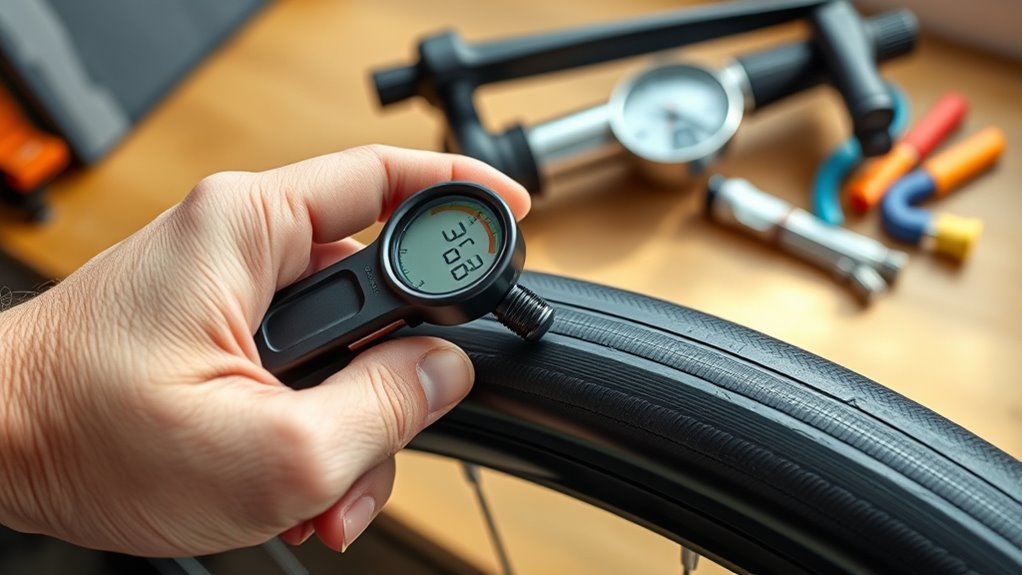
Accurately checking and adjusting your bike tire pressure guarantees peak performance and safety on every ride. To do this, you need the right tools and techniques. Use a high-quality, bike-specific pressure gauge to measure tire pressure accurately, ideally before each ride when tires are cold. When inflating tires, do so slowly with a floor pump that has a built-in gauge, which helps prevent overinflation and ensures precise control. For on-the-go adjustments, a reliable hand pump with a gauge is essential. If using an air compressor, set the pressure carefully to avoid exceeding the maximum PSI. Remember these key points:
- Use a pressure gauge for accurate readings
- Measure tire pressure regularly
- Inflate tires gradually for control
- Adjust pressure based on recommended PSI range
Common Myths and Misconceptions About Bike Tire Pressure

Many cyclists believe that inflating tires to their maximum PSI guarantees the best performance, but this is a misconception. Myths about tire pressure often lead riders to overinflate, thinking it boosts speed and reduces flats. In reality, proper tire pressure varies based on terrain, rider weight, and conditions. Lower pressures can improve bike riding by offering better grip and comfort, and they can even decrease the risk of flats on rough surfaces. The myth that tire pressure stays constant over time is false—regular checks are essential because temperature and terrain cause pressure changes. Overinflated tires don’t prevent flats; they can increase the chance of blowouts and reduce traction. Understanding these myths helps you optimize your bike riding experience and maintain safer, more efficient tire pressure.
The Impact of Weather and Terrain on Tire Pressure Needs
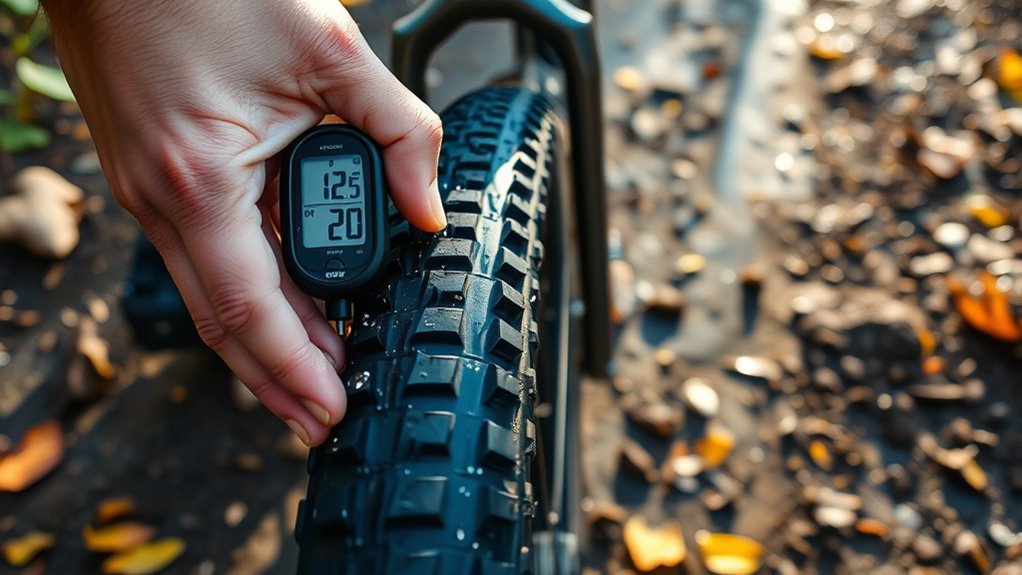
Weather and terrain play a crucial role in determining the ideal tire pressure for your bike. Changes in weather cause pressure fluctuations—hot weather expands air, risking overinflation, while cold causes pressure drops, leading to underinflation. Rough terrain often requires lower pressures to boost traction and absorb shocks, preventing pinch flats and rim damage. Conversely, smooth surfaces benefit from higher pressures, reducing rolling resistance and increasing speed, especially in dry conditions. Temperature fluctuations during your ride can alter tire pressure by about 1-2 PSI per 10°C change, so check your pressure regularly. Being mindful of these factors guarantees maximum grip, comfort, and safety. Remember:
- Hot weather increases pressure
- Cold weather decreases pressure
- Rough terrain needs lower pressure
- Smooth terrain benefits from higher pressure
Frequently Asked Questions
What Is a Good Tire Pressure for a Bike?
A good tire pressure for your bike depends on your bike type and riding conditions. For road bikes, aim for around 100-120 PSI for speed and comfort on smooth surfaces. Mountain bikes usually perform best at 30-50 PSI to maximize traction. Check your tire’s sidewall for manufacturer recommendations, and modify pressure based on terrain, rider weight, and weather. Regularly maintaining your tires ensures a safer, smoother ride.
Is 40 PSI Too High for a Bike?
Did you know that riding with improper tire pressure can increase your chances of flats by up to 30%? For most bikes, 40 PSI isn’t too high; it’s within the recommended range for mountain and road tires. However, if your tire’s manufacturer suggests a lower PSI, overinflating can cause a harsh ride and blowouts. Always check your tire’s recommended pressure to keep your ride safe and smooth.
Is 35 PSI Too High for a Bike?
You ask if 35 PSI is too high for your bike. It depends on your tire width and riding style. For wider tires (28-35mm), 35 PSI is usually just right, offering good traction and comfort. But if you have narrow tires (23-25mm), 35 PSI might be too low, causing sluggishness and flats. Always check your tire’s recommended pressure and adjust based on terrain and load for ideal performance.
What Happens if Bike Tire Pressure Is Too Low?
If your bike tire pressure is too low, you’ll notice a sluggish ride and increased effort, making pedaling feel like a chore. It also compromises your safety—tires are more prone to pinch flats, rim damage, and slipping on wet or uneven surfaces. Meanwhile, the ride becomes rough and uncomfortable, causing fatigue. Low pressure might seem harmless, but it can lead to faster tire wear and even dangerous blowouts, risking your ride and safety.
Conclusion
By mastering the mechanics of maintaining proper tire pressure, you maximize mileage, minimize mishaps, and make every ride reliable and rewarding. Remember, consistent checks and careful calibration cultivate confidence on challenging terrains, while combating common misconceptions clarifies your cycling journey. Stay savvy with sensors, stay sharp with science, and stay spirited in your pursuit of perfect pressure. Properly pressured tires propel your passion, providing power, precision, and peace of mind on every pedal stroke.


